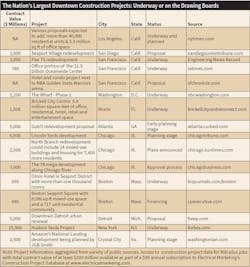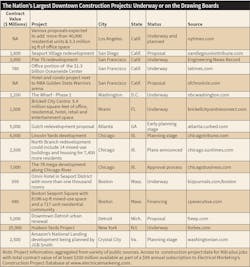When you look at the tepid +1.1% year-over-year (YOY) growth in the top-line construction data reported in the U.S. Census Bureau’s most recent Value of New Construction report, you might assume not much is happening in the commercial construction market.
That’s definitely not the case in the urban core of cities now being transformed by multi-billion-dollar, mixed-use construction projects loaded with new multi-family housing, retail space, offices, and mass transit stations. And when you figure that electrical construction accounts for an estimated 10% of the total cost of a construction project, it quickly becomes apparent just how much these huge urban revitalization projects can impact the electrical market.
We first started seeing construction projects of this scale several years ago when the Hudson Yards project broke ground on Manhattan’s West Side on a 26-acre parcel of land near the Hudson River that was, for the most part, parking lots and a rail yard. Forbes magazine said at the time of its groundbreaking in 2012 that Hudson Yards would eventually total $25 billion in construction work. When it broke ground, Hudson Yards was the largest project the United States and the biggest construction project in New York City since Rockefeller Center construction commenced in 1931. Some published estimates peg the total number of construction jobs created by Hudson Yards at 23,000 construction workers (including, by our estimates, more than 2,900 electrical workers). When finished, Hudson Yards is expected to accommodate 40,000 people living in million-dollar apartments in one of its condo towers with killer views of NYC and the Hudson River or working in one of the many office towers.
Although none of the other major downtown revitalization projects underway or on the drawing boards in the United States is quite as big as Hudson Yards, they were all designed with the same “live-work-play” trend in mind, where residents are often millennials who want to live close to where they work in cities or empty nesters who want to down-size from their suburban homes and live closer to urban amenities.
Other downtown revitalization projects underway or in the planning stage include the following:
• The creation of Boston’s Seaport District, which, over the past few years, has added thousands of new housing units and acres of new office space
• Approximately $6 billion worth of construction in Detroit, including Michigan’s tallest office building and Ford Motor Co.’s $350 million redevelopment of the Michigan Central Train Station that is part of a $740-million plans for a new office campus in the city’s Corktown neighborhood.
• The $2.2-billion second phase of the Wharf in Washington, D.C., and Amazon’s $2.5 billion headquarters across the Potomac River in Crystal City, Va.
• Atlanta’s $5-billion Gulch redevelopment and Tampa’s $3-billion Water Street project.
• Several ambitious redevelopment projects in Chicago, including the $6-billion Lincoln Yards development.
This list doesn’t even include what’s going on in Seattle, where at least 60 construction cranes now reportedly pierce the sky, or the billions of dollars being poured into construction projects all over San Francisco (see the Table).
On the electrical front, these gigantic mixed-use urban projects often include amenities that you don’t always see in new developments. G&G Electric Supply, a Manhattan-based electrical distributor located several blocks from Hudson Yards, says it’s not unusual for the luxury condos being built in New York to include top-shelf lighting control systems. Turtle & Hughes, an electrical distributor based in Linden, N.J., supplied switchgear and related products for the Hudson Yards microgrid that’s backing up the primary service for the project. According to the Turtle & Hughes Technology Blog, the switchgear was installed in two co-generation plants that are part of the complex’s smart microgrid, which is “designed to keep Hudson Yards running even if the national grid goes down.”
“The switchgear our team built into the microgrid is instrumental in keeping it ready, reliable, and efficient as it seamlessly transfers power from the national grid to local power, when required,” reads a post in the Turtle & Hughes blog. “By building a redundant system using a combination of ring-breakers, the microgrid can be prevented from ever going down. The smart microgrid also has two-way digital communication between smart devices to the national grid. This provides data that can be analyzed to ensure that whenever there is going to be a disruption in power, the Hudson Yards grid is ready to take over.
“Microgrid technology along with new battery storage systems are ushering in a new age of power management and providing opportunities for a wide range of commercial, industrial and utility scale applications. The goal for all types of alternative grids is the same as those at Hudson Yards: better security, more efficient transmission, a resilient infrastructure, and lower costs for consumers.”
Trophy jobs like these large downtown projects of this size don’t come along every day, and when they do hit your market, everybody is scrambling to get a piece of the action. Enjoy them when they do come to town, but never overlook the reality that over the long haul much smaller projects will account for much more of the work in your market area.
About the Author
Jim Lucy
Editor-in-Chief, Electrical Wholesaling & Electrical Marketing
Over the past 40-plus years, hundreds of Jim’s articles have been published in Electrical Wholesaling, Electrical Marketing newsletter and Electrical Construction & Maintenance magazine on topics such as electric vehicles, solar and wind development, energy-efficient lighting and local market economics. In addition to his published work, Jim regularly gives presentations on these topics to C-suite executives, industry groups and investment analysts.
He launched a new subscription-based data product for Electrical Marketing that offers electrical sales potential estimates and related market data for more than 300 metropolitan areas. In 1999, he published his first book, “The Electrical Marketer’s Survival Guide” for electrical industry executives looking for an overview of key market trends.
While managing Electrical Wholesaling’s editorial operations, Jim and the publication’s staff won several Jesse H. Neal awards for editorial excellence, the highest honor in the business press, and numerous national and regional awards from the American Society of Business Press Editors. He has a master’s degree in communications and a bachelor’s degree in journalism from Glassboro State College, Glassboro, N.J. (now Rowan University) and studied electrical design at New York University and graphic design at the School for Visual Arts.


